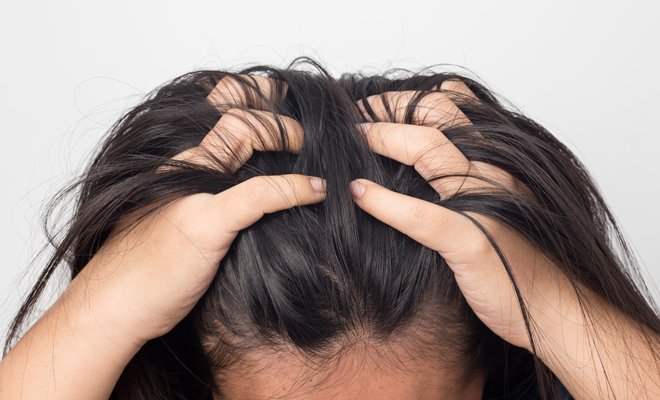We already know some of the most frequent Obsessive Compulsive Disorders, such as continuous hand washing, repeating words or symmetry disorder, for example. But in this case we are going to focus on an important problem that causes great damage to the skin. It is about dermatillomania, which leads you to compulsively scratch until you tear your skin. Sounds dangerous, right? It is, so you have to seek treatment as soon as possible.

What is dermatillomania?
Dermatillomania is an anxiety disorder that is characterized by scratching, picking or excoriating the skin to the point of making wounds. Skin lesions can become very important and have a risk of infection. It is one more Obsessive Compulsive Disorder, with the same causes and consequences, and is often accompanied by a depressive disorder.
In any case, as with all OCD, dermatillomania is, at its core, an anxiety disorder taken to the limit, although it also has certain similarities with addictions. Scratching the skin until it hurts is the only relief from anxiety that people with this disorder find. At first they do it only on occasions of great stress or in situations of great emotional charge, but later it becomes a repetitive act that increases.
Symptoms of dermatillomania
Surely you have ever experienced great pleasure in ripping off that scab that appears when a skin wound is healing. You will have seen that when you tear it off, it comes out again and you cannot help but tear it off again even though you know that you are delaying its complete healing. Doesn’t worry, that doesn’t mean you suffer from dermatillomania, we’re just writing it down so you can empathize with this misunderstood disease.
And what about that pimple on your face that you remove knowing that it would be better to let it be? People with dermatillomania take this gesture to the extreme of producing wounds that can become infected. The extremities, the scalp, the chest and the back are the places where the signs of this disease are most evident.
The dermatillomania process
The process begins with a high load of anxiety impossible to bear. Any situation that can cause anxiety, insecurity or nervousness is the ideal time for the obsession to appear. After all, dermatillomania is OCD. An obsession that may be due to anxiety itself knowing that that person is going to suffer a moment of great emotional tension and needs some trick to calm down.
He finds it in scratching, in picking his skin. And at first he succeeds. Anxiety is reduced and it seems that she has found the ultimate trick to overcome anxiety. Obviously this is not the case and each time he will find more delicate situations and each time the intensity of his compulsion will increase because a slight scratching no longer relieves him. This is how he enters the circle of obsessions and compulsions.
Differences within dermatillomania
Dermatillomania differs from other OCD because it has two differentiated variants in terms of its function or in terms of the situation that causes the process:
The OCD aspect of dermatillomania is associated with contamination OCD. The feeling that the person is contaminated leads them to cause these skin lesions as well as the compulsion to wash continuously. It gives the feeling that the contamination will go away if you scratch the area intensely.
The relationship with anxiety is seen in the anxiolytic function of the compulsion to scratch. Faced with a potentially stressful situation for the person, scratching the skin is the only relief in the event that the escape or avoidance strategy cannot be used.
Consequences of dermatillomania
Skin wounds are the most obvious and direct consequence of dermatillomania. But let’s not forget that it is a repetitive action that can cause great dermatological damage. People with this disorder usually don’t stop until they bleed and beyond, so wounds often become infected.
In the most severe cases of dermatillomania, scarring and disfigurement occur, making it even more apparent that a problem exists. A disorder that is perfectly visible from the outside and that makes the psychological consequences appear, those that can be both cause and consequence of dermatillomania.
Causes of dermatillomania
As we say, the consequences of dermatillomania are sometimes the same as the causes. When the person sees their skin full of wounds or disfigured, a feeling of guilt, shame and insecurity typical of low self-esteem occurs. This only increases the number of times that the compulsion to scratch is performed and, at the same time, the problem of self-esteem.
On the other hand, the person who suffers from this disorder is aware that something is wrong, especially their lack of self-control. Why can’t she avoid injuring herself? And precisely the obsession with control is one of the main causes of anxiety.
If we point to the origin of dermatillomania, some point to the genetic factor as important. But the truth is that most cases originate from psychosocial stress. Situations of work stress, problems in social, family and love relationships or a traumatic episode are the most common when triggering this OCD.
Added to a previous anxiety disorder, a low tolerance for frustration and a need for immediate reward, we have the main ingredients of this disorder that can also be linked to depression, alcohol or drug abuse and eating disorders.
Dermatillomania Treatment
As you can imagine, dermatillomania is a complex disorder that cannot be encompassed in a single area. And the same goes for its treatment, which will have to address the different causes and consequences of the disorder.
Generally, you can go to cognitive behavioral therapy to initially work on the negative thoughts that lead to obsessions. At the same time, it will be necessary to treat the anxiety and depression with which dermatilomania is combined in most cases. And, of course, intense work is urgently needed to improve self-esteem.
The next step is to transform the compulsive behavior, that of scratching the skin, by means of the habit reversal technique with which, little by little, the person will verify that scratching or picking the skin is not the only action that can be carried out to relieve your anxiety.
Undoubtedly, it is a complex and long treatment that must be carried out by one or several professionals, since in many cases psychological therapy must be accompanied by pharmacological treatment. And as always when we talk about anxiety-related disorders, one can promote the effectiveness of the treatment and protect oneself against new disorders by regularly practicing relaxation techniques.
Dermatillomania is still another face of anxiety and we already know that it is not about fighting anxiety, but about learning to manage it in the healthiest way.






